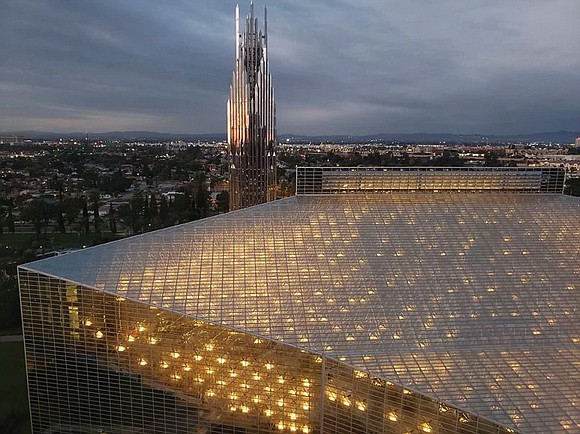Crystal Cathedral, former home of ‘Hour of Power’ to become Roman Catholic seat
Religion News Service | 1/4/2019, 6 a.m.
GARDEN GROVE, Calif.
For nearly 30 years, the Rev. Robert Schuller’s Crystal Cathedral was not only a religious landmark, but an architectural wonder and an embodiment of flush times in Southern California’s Orange County.
Rev. Schuller, who began preaching to motorists at a drive-in movie theater in 1955, captured the ebullient positivity of mid-century America, and by the 1970s he was one of the country’s top televangelists, best known for his broadcast, “Hour of Power.” The symbol of his success was the Crystal Cathedral, a 128-foot-tall building designed by the cutting-edge modernist architect Philip Johnson to be the largest glass building in the world.
From the top, you can see Disneyland. Inside seats almost 3,000. On holidays, services included live animals and acrobatic performers. It was a physical representation of the limitless hopes of the evangelical community of the time.
But the landscape began to change.
Around the turn of the 21st century, Rev. Schuller’s large following of white evangelicals was aging, and the population of nonwhite residents in California was increasing. Membership and donations to Crystal Cathedral began to decline. The cathedral filed for bankruptcy in 2010.
At the same time, the Roman Catholic Church started seeing an increase in Southern California. In 1976, the Diocese of Orange consisted of about 300,000 Catholics. Today, the numbers are closer to 1.6 million, supporting 62 parishes, 41 schools, three hospitals and care centers and a number of agencies serving the poor, according to The Orange County Register.
“It’s like, ‘Where are all these people coming from?’ They keep coming and coming,” said Hank Evers, director of strategic communications for the Diocese of Orange, adding that the overall population growth of the area impacted everything from the economy to the local churches.
Fittingly, then, Crystal Cathedral is almost ready to open as a church again — this time as Christ Cathedral, seat of the Diocese of Orange.
“It’s the carrying on of a legacy that was begun before us,” said the Rev. Christopher Smith, a priest at Christ Cathedral.
“We’re buying a used cathedral, and that’s never happened before.”
For one thing, the Diocese of Orange wasn’t even the highest bidder. But at Rev. Schuller’s request, the bankruptcy judge awarded the Diocese of Orange the campus for $57.5 million.
Then came the hard part. Crystal Cathedral needed major repairs and would have to be adapted to serve as a Catholic facility. The new focus of Mr. Evers’ capital campaign was raising money for its transformation. The final numbers were just too high — $25 million to $30 million over budget.
The diocese brought in Richard Heim, division CEO for Clark Construction Group and a local Catholic. By cutting back on construction costs on what Mr. Heim refers to as “back of the house” features that few worshippers would notice, the diocese was able to save millions of dollars. The total cost of acquiring and adapting the building, at a little more than $100 million, came to about half that of building a new cathedral.
“We had to strike a balance between the architectural significance, the functionality of the space, but also bring it in within the available funds,” Mr. Heim said.
Some of the changes were small, such as switching from English walnut to red oak for the pews and looking at a wider range of flooring. The entire glass facade and roof had to be recaulked to withstand an earthquake.
“It is not the traditional stone concrete cathedrals that you would see in Europe that would last 500 years,” Mr. Heim said. “We are restoring a glass cathedral in the middle of a seismic zone in California, which is a bit of a challenge.”
To transform the building into a place for Catholic Mass, a substantial altar area replaced Rev. Schuller’s pulpit in the middle of the predella, giving it a central place in the cathedral and a major focal point. Limestone walls have been erected to create a sense of enclosure, and 11,000 panels, called quatrefoils, hung toward the ceiling help control temperature, monitor the acoustics and create a more somber atmosphere. The Hazel Wright Organ, one of the largest church instruments in the world, named for the “Hour of Power” viewer who donated the money for it, has been moved to a side.
Some architecture critics have taken exception to the changes, saying they diminish the openness of the Johnson design. But the diocese feels that it has done much to preserve the beauty of the cathedral, which it considers a boon to the local community, while accommodating the diocese’s needs.
“The building is going to continue its journey and its purpose of meeting the spiritual purpose of the people,” Mr. Heim said.







